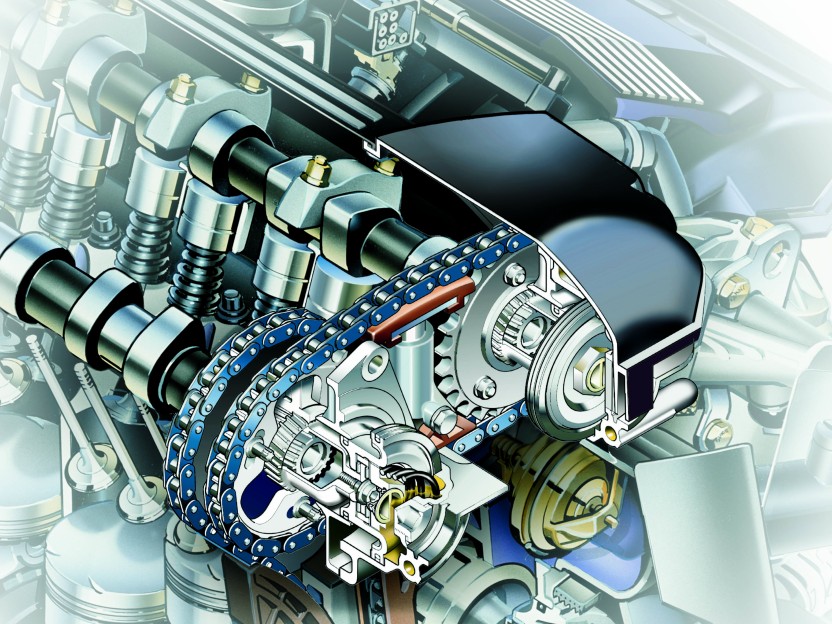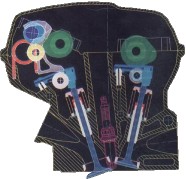|
BMW Double VANOS

VANOS is a combined
hydraulic and mechanical camshaft control device managed by the
car's DME engine management system.
The VANOS system is based on an adjustment mechanism that can modify
the position of the intake camshaft versus the crankshaft.
Double-VANOS adds an adjustment of the intake and outlet camshafts.
VANOS operates on the intake camshaft in accordance with engine
speed and accelerator pedal position. At the lower end of the
engine-speed scale, the intake valves are opened later, which
improves idling quality and smoothness. At moderate engine speeds,
the intake valves open much earlier, which boosts torque and permits
exhaust gas re-circulation inside the combustion chambers, reducing
fuel consumption and exhaust emissions. Finally, at high engine
speeds, intake valve opening is once again delayed, so that full
power can be developed.
VANOS significantly enhances emission management, increases output
and torque, and offers better idling quality and fuel economy. The
latest version of VANOS is double-VANOS, used in the new M3.
Here's how it works:
In overhead cam engines, the cams are connected to the crankshaft by
either a belt or chain and gears. In BMW VANOS motors there is a
chain and some sprockets.
The crankshaft drives a sprocket on the exhaust cam, and the exhaust
cam sprocket is bolted to the exhaust cam. A second set of teeth
moves a second chain that goes across to the intake cam. The big
sprocket on the intake cam is not bolted to the cam, for it has a
big hole in the middle. Inside the hole is a helical set of teeth.
On the end of the cam is a gear that is also helical on the outside,
but it's too small to connect to the teeth on the inside of the big
sprocket. There is a little cup of metal with helical teeth to match
the cam on the inside and to match the sprocket on the outside. The
V (Variable) in VANOS is due to the helical nature of the teeth. The
cup gear is moved by a hydraulic mechanism that works on oil
pressure controlled by the DME.

At idle, the cam timing
is retarded. Just off idle, the DME energizes a solenoid which
allows oil pressure to move that cup gear to advance the cam 12.5
degrees at midrange, and then at about 5000 rpm, it allows it to
come back to the original position. The greater advance causes
better cylinder fill at mid rpm for better torque. The noise some
people hear is the result of tolerances that make the sprocket
wiggle a bit as the cup gear is moved in or out.
Double VANOS
Double-VANOS (double-variable camshaft control) significantly
improves torque since valve timing on both the intake and outlet
camshafts are adjusted to the power required from the engine as a
function of gas pedal position and engine speed.
On most BMW engines
that use a single VANOS, the timing of the intake cam is only
changed at two distinct rpm points, while on the double-VANOS
system, the timing of the intake and exhaust cams are continuously
variable throughout the majority of the rpm range.
With double-VANOS, the opening period of the intake valves are
extended by 12 degrees with an increase in valve lift by 0.9 mm.
Double-VANOS requires very high oil pressure in order to adjust the
camshafts very quickly and accurately, ensuring better torque at low
engine speeds and better power at high speeds. With the amount of
un-burnt residual gases being reduced, engine idle is improved.
Special engine management control maps for the warm-up phase help
the catalytic converter reach operating temperature sooner.
Double-VANOS improves low rpm power, flattens the torque curve, and
widens the powerband for a given set of camshafts. The double-VANOS
engine has a 450 rpm lower torque peak and a 200 rpm higher
horsepower peak than single-VANOS, and the torque curve is improved
between 1500 - 3800 rpm. At the same time, the torque does not fall
off as fast past the horsepower peak.
The advantage of double-VANOS is that the system controls the flow
of hot exhaust gases into the intake manifold individually for all
operating conditions. This is referred to as "internal" exhaust gas
re-circulation, allowing very fine dosage of the amount of exhaust
gas recycled.
While the engine is warming up, VANOS improves the fuel/air mixture
and helps to quickly warm up the catalytic converter to its normal
operating temperature. When the engine is idling, the system keeps
idle speeds smooth and consistent thanks to the reduction of exhaust
gas re-circulation to a minimum. Under part load, exhaust gas
re-circulation is increased to a much higher level, allowing the
engine to run on a wider opening angle of the throttle butterfly in
the interest of greater fuel economy. Under full load, the system
switches back to a low re-circulation volume providing the cylinders
with as much oxygen as possible.
Original Text:
http://www.bmwworld.com/technology/vanos.htm |
|
BMW M54 Engine
In an era of V-6
designs, why a straight-six?
The laws of physics; a straight-six power unit offers the optimum
physical configuration for a six-cylinder engine.
The near perfect inner balance of the straight-six means an absence
of free mass forces.
The straight-six does not require balance shafts and elaborate
engine mounts to overcome the inherent vibrations of other designs.
With valve drive systems becoming more complex, there are
engineering advantages in having only one cylinder head and only one
valve train.
The Design of the Straight-Six
More power, more fuel economy. Here's how:
The M54 has an aluminum crankcase with cast cylinder liners. The
engine size has been increased from the 2.8 liters of the M52 model
to 3.0 liters by increasing the cylinder stroke from 84.0 to 89.6
mm. With the increase in engine size, engine power has been
increased from 142 kW/193 hp to 170 kW/231 hp. The increase in the
opening period of the intake valves resulted in an increase of 3.5
kW/4.8 hp in engine output. The intake and exhaust manifolds have
been streamlined. This improvement contributed 16 kW/22 hp to the
increase in engine output. Other refinements result from reducing
piston friction and cutting back the engine's idle speed.
Electronic Throttle Butterfly
The throttle butterfly has now been replaced by a fully
electronic version.
The system recognizes the gear in which the car is driving and is
thus able to activate an individually programmed throttle butterfly
control line for each gear. Cruise control has been integrated
within the electronic throttle butterfly. Since there are no
conventional mechanical linkage bars, there is a reduction of gas
pedal forces. The phrase "step on the gas" takes on a whole new
meaning! The controls stored within the engine management system
have increased to over 600 different operating modes.
Engine Reliability
The M54 is the most reliable BMW engine ever built. Here's why:
The camshaft chain drive and the V-belt drive are maintenance-free
and designed for the life of the engine.
Valve clearances are kept consistent throughout the entire running
life of the engine by a self-adjusting hydraulic valve clearance
mechanism. There is no need to adjust valve clearances, ever.
There is no need to reset the clutch since it is self-adjusting.
The air filters and spark plugs only have to be replaced after
100,000 km or 62,000 miles.
The oil in the transmission and final drive is a lifetime filling
not requiring any replacement.
There is no need for any particular running-in service.
The BMW Service Interval Indicator informs the driver of the
remaining distance until the next oil change. You no longer have to
change the oil after a fixed, rigid mileage.
The engine is able to adjust automatically to all fuel grades
between 87 and 98 octane.
Anti-knock control automatically adjusts the engine's running
conditions to the respective fuel grade and quality.
Please note that the engine's maximum output is only achieved when
running on 98 octane premium fuel.
Specifications of 3.0L
Configuration - Straight-six
Market launch Year 2000
Max output kW/bhp 170 / 231 at 5900 rpm
Max torque Nm(lb-ft) 300 (221) from 3500-4750 rpm
Combustion process - Intake manifold injection / throttle control /
lambda = 1.0
Capacity, effective cc 2979.3
Compression ratio - 10.2
Bore / stroke mm 84 / 89.6
Crankcase material - Aluminum (AISi9Cu3) with cylinder liners
Height of cylinder block mm 211.0
Distance between cylinders mm 91
Topland mm 7
Main bearing diameter mm 60.0
Conrod bearing diameter mm 45.0
Conrod length mm 135, crack technology
Cylinder head material - Aluminum ((AISi6CU4)
Camshafts - 2 chain-driven camshafts running in 7 bearings and with
ultra-fine balance
Camshaft adjustment - Hydraulically infinitely variable phase
adjustment of the intake and outlet camshafts
Valve drive Cup tappets with hydraulic valve play compensation
Valve diameter intake/outlet mm 33.0 / 30.5
Valve shaft diameter intake/outlet 6.0 / 6.0
Valve angle intake/outlet 20 o 15' / 19 o 15'
Max valve lift, intake mm 9.7
Max valve lift, outlet mm 9.0
Opening period, intake o CS 240
Opening period, outlet o CS 244
Intake angle range o CS 86 - 126, infinitely variable
Outlet angle range o CS 80 - 105, infinitely variable
Intake manifold - Two-chamber resonance intake system with
additional turbulence unit
Engine weight according to BMW standard kg / lb 170 / 375
Engine management / fuel supply - Siemens MS43 / sequential
multipoint injection / fully electronic throttle butterfly
adjustment / additional turbulence system adjuster
Fuel grade RON 87 - 98 (rated output with 98 ROM fuel)
Certified emission standard - EU 4 / ULEV
Exhaust system - Shell manifold with three-way main catalysts close
to the engine; additional secondary air injection in some markets
Original Text:
http://www.bmwworld.com/engines/m54.htm |

